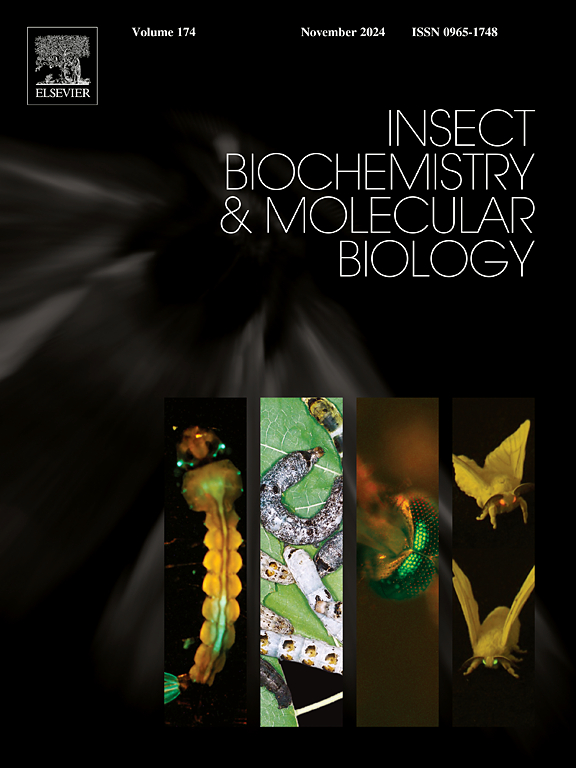模式识别、血淋巴蛋白酶-14激活和可溶性肽聚糖识别蛋白对溶菌酶介导的细菌杀伤的增强作用。
IF 3.7
2区 农林科学
Q2 BIOCHEMISTRY & MOLECULAR BIOLOGY
引用次数: 0
摘要
肽聚糖识别蛋白(PGRPs)在昆虫免疫反应中检测入侵细菌,有些可以破坏细菌细胞壁。我们之前生产了m.s sexta的PGRP 1- 5,12和13,并证明了血淋巴中的PGRP库优先检测中二氨基戊酸肽聚糖(DAP-PGs)。在本研究中,我们发现在幼虫血淋巴中添加DAP-PGs和PGRPs显著提高了酚氧化酶原的活性,超过了它们个体效应的总和。黄体微球菌的Lys-PG与PGRP4/5也表现出协同作用,而金黄色葡萄球菌的Lys-PG则没有协同作用。结构建模和配体对接支持dap - pg优于lys - pg的结合。DAP/Lys-PG、PGRP3s/3f/5/13N和微生物结合蛋白激活了血淋巴蛋白酶-14 (HP14),提示这些PGRPs启动丝氨酸蛋白酶系统的方式与PGRP1相同。以荧光素标记的黄豆肽聚糖为底物,我们检测到PGRP2、4、13N、12e和3f引起的荧光信号增加,表明这些PGRPs具有水解肽聚糖的酰胺酶活性,Zn2+增强了酶活性,EDTA降低了酶活性。pgrp -肽聚糖复合物模型中催化残基、Zn2+离子和可剪切键的空间位置解释了一些活性差异。PGRP2和PGRP4的比活性最高。与对照组相比,只有PGRP4 (60 μg/ml)降低了巨型芽孢杆菌菌落形成单位(CFU),而其他PGRPs对CFU数量没有影响。与单独溶菌酶相比,PGRP1-5或3s (2 μg/ml)与Manduca溶菌酶(20 μg/ml)的混合物显著降低CFU,即使不具有酰胺酶活性的PGRPs也是如此。扫描电镜显示,溶菌酶对细菌细胞壁造成结构损伤,当与PGRP2结合时,这种作用增强。综上所述,可溶性PGRPs优先识别DAP-PGs,通过HP14刺激黑色素化,并增强溶菌酶对细菌的杀伤作用。pgrp和溶菌酶对不依赖于酰胺酶的细菌的杀伤机制有待进一步探索。本文章由计算机程序翻译,如有差异,请以英文原文为准。

Pattern recognition, hemolymph protease-14 activation, and enhancement of lysozyme-mediated bacteria killing by soluble peptidoglycan recognition proteins in Manduca sexta
Peptidoglycan recognition proteins (PGRPs) detect invading bacteria during insect immune responses, and some can damage bacterial cell walls. We previously produced M. sexta PGRPs 1–5, 12, and 13, and demonstrated that the PGRP repertoire in hemolymph preferentially detects meso-diaminopimelic acid-peptidoglycans (DAP-PGs). In this study, we found that adding DAP-PGs and PGRPs to larval hemolymph significantly enhanced prophenoloxidase activation beyond the sum of their individual effects. Lys-PG of Micrococcus luteus and PGRP4/5 also displayed the synergy, but Lys-PG of Staphyloccous aureus did not. Structural modeling and ligand docking supported the preferrential binding of DAP-PGs over Lys-PGs. DAP/Lys-PG, PGRP3s/3f/5/13N, and microbe binding protein activated hemolymph protease-14 (HP14), suggesting that these PGRPs initiate the serine protease system in the same way as PGRP1. Using fluorescein-labeled M. luteus peptidoglycan as a substrate, we detected increases in fluorescence signal caused by PGRP2, 4, 13N, 12e, and 3f, suggesting that these PGRPs have amidase activity for hydrolyzing peptidoglycan, which was enhanced by Zn2+ and decreased by EDTA. Spatial locations of the catalytic residues, Zn2+ ion, and scissile bond in the models of PGRP-peptidoglycan complexes explained some of the activity differences. PGRP2 and PGRP4 had the highest specific activity. Only PGRP4 (60 μg/ml) decreased Bacillus megaterium colony-forming units (CFU) compared to controls, whereas other PGRPs did not affect CFU numbers. A mixture of PGRP1−5 or 3s (2 μg/ml) and Manduca lysozyme (20 μg/ml) significantly reduced CFU compared to lysozyme alone, even for PGRPs without amidase activity. Scanning electron microscopy revealed that lysozyme caused structural damage to the bacterial cell walls, and when combined with PGRP2, this effect was enhanced. In summary, the soluble PGRPs preferentially recognize DAP-PGs, stimulate melanization via HP14, and enhance bacterial killing by lysozyme. Mechanisms for the amidase-independent bacterial killing by PGRPs and lysozyme require further exploration.
求助全文
通过发布文献求助,成功后即可免费获取论文全文。
去求助
来源期刊
CiteScore
7.40
自引率
5.30%
发文量
105
审稿时长
40 days
期刊介绍:
This international journal publishes original contributions and mini-reviews in the fields of insect biochemistry and insect molecular biology. Main areas of interest are neurochemistry, hormone and pheromone biochemistry, enzymes and metabolism, hormone action and gene regulation, gene characterization and structure, pharmacology, immunology and cell and tissue culture. Papers on the biochemistry and molecular biology of other groups of arthropods are published if of general interest to the readership. Technique papers will be considered for publication if they significantly advance the field of insect biochemistry and molecular biology in the opinion of the Editors and Editorial Board.

 求助内容:
求助内容: 应助结果提醒方式:
应助结果提醒方式:


